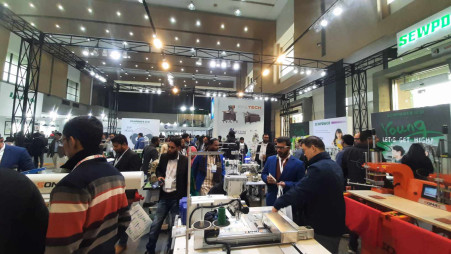Modern textile, RMG machinery on display under one roof
A huge embroidery machine is drawing designs on the cloth one after another. This machine can accomplish six types of designs simultaneously according to the computer’s instructions. A man is just controlling the machine.
International Convention City, Bashundhara (ICCB) in the capital has now worn the look of a big textile factory with the sounds of running machines. Some are sewing, some are cutting, while some are fixing buttons on apparels.
Latest knitting, dyeing and washing machines of the readymade apparel sector are also running seamlessly alongside the modern embroidery machines.
Two concurrent events -GTB 2024, international textile and garment machinery expo, and GAP 2024, a garment accessories and packaging machinery expo- kicked off at the convention centre from Thursday to showcase the latest technology of the sector.

Photo: Jahir Rayhan
Mohammad Nahid, manager of Champion Family, which imports and sells SINSIM brand China-made embroidery machines in Bangladesh, told The Business Standard, “This machine is new in Bangladesh. 6 types of embroidery can be designed simultaneously.”
SINSIM company produces and sells high-end computerised embroidery machines.
Managing Director of Ask Trade and Exhibitions Tipu Sultan Bhuiyan told TBS, “The four-day event spread over eight halls has participation of 300 exhibitors from over 20 countries including Japan, China, Italy, Japan, Taiwan, Turkey, Malaysia.”
He said the use of technology is increasing in Bangladesh. Bangladesh is the first garment factory in the world to receive Leadership in Energy and Environmental Design (LEAD) recognition. As a result, the demand for modern machinery is increasing.
“90% of our machines have to be imported from abroad. So, this event has been organised under one roof so that the entrepreneurs can easily get acquainted with the modern technology. Some indigenous machines are also on display here. There are about 600 stalls.”

Photo: Jahir Rayhan
To survive the competition, the entrepreneurs of Bangladesh’s RMG sector have increased the use of machines in factories, lowering the requirement for a large workforce.
At the fair venue, Ashraful Hasaan, proprietor of TEX.forest, said, “I’ll set up a new garment factory. I came here to see modern machines. I have collected their catalogues and numbers to contact the vendors later.”
Manager of Ha-Meem Accessories, a subsidiary is a company of HA-MEEM Group, Ashraful Alam told TBS, “We are using modern technology machines in our company to produce garment Accessories. As a result, foreign buyers are getting all kinds of support from us at the same place.”
In addition to the permanent four halls, the fair has been organised in another four temporary halls, where textile and garment machinery are being displayed.

Photo: Jahir Rayhan
On Friday, entrepreneurs and visitors from related sectors showed interest in the innovative activities of various automatic machines. Various uses of machinery, yarns, fabrics, dyes, raw materials and chemicals in the textile and apparel industry are being showcased at the fair. The stall staff is giving necessary information about the products to the visitors.
The workers at the stall are running the machines. They show visitors how these machines work. It shows how different designs are printed on garments.
Apart from this, finishing irons produced by world renowned companies are on display. There are also international quality swing, knitting, embroidery, laundry, finishing, dyeing, CAD or CAM, printing, cutting, spreading machinery.
Various companies are presenting their latest collection of machines for the knit industry.

Photo: Jahir Rayhan
The official of Autroy art informed that their automatic pant pocket sewing machines can sew 5,000 pant pockets in 10 hours with the double-head machines.
One of the stalls at the exhibition was that of Micro Trims Limited. The company is exhibiting Garment Accessories. The company’s Assistant General Manager Mahmudul Basit Porash Told TBS, “We are now moving towards sustainability.”
He said, “We are using eco-friendly organic cotton. We import organic cotton from India. It is certified. Now foreign buyers want sustainable products.” News Sources : tbsnews


















